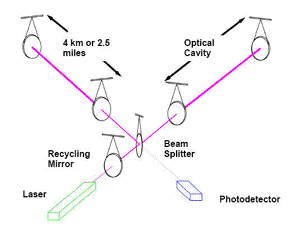Blog
Shaken, Not Stirred
6 March 2014
One of the predictions of general relativity is that the motion of large masses, such as a binary system of black holes or neutron stars, should produce gravitational waves. When most people think of waves they typically think of water waves. Drop a pebble in a calm pond and you can watch the waves spread out over the surface of the water. Gravity waves are similar, but are ripples in the fabric of space and time itself. There is a project looking for these gravitational waves, known as the Laser Interferometer Gravitational-Wave Observatory, or LIGO.
We actually have a great deal of evidence for gravity waves. For one, they are a consequence of general relativity, which has passed every observational test we’ve made of it so far. We also have indirect evidence of gravitational waves through an effect known as inspiralling. When two stars orbit each other, they produce gravitational waves. The gravity waves in turn take away some of the energy from the binary system. This means that the two stars gradually move closer together, or inspiral. As the two stars inspiral, their orbital period gets shorter (because their orbits are getting smaller). We have observed this effect with a pulsar orbiting a companion star, and the result is exactly that predicted by gravitational waves.
 LIGO/MIT
LIGO/MITStill, we’d like to detect gravitational waves directly, which is where LIGO comes in. Because gravitational waves create ripples in space, the distance between objects shift slightly as a gravitational passes by. This means by making precise measurements of the relative positions of objects, we can in principle detect these waves. The difficulty is that even gravity waves produced by binary black holes will only cause small distortions of an experiment here on Earth. This is why LIGO uses laser interferometry along a beam 4 kilometers long. Even then, the expected distortion would be about a billionth of a nanometer.
So far, the LIGO project hasn’t had a confirmed detection of gravity waves, but it is hoped that upgrades to the project currently under way will allow the project to be successful.